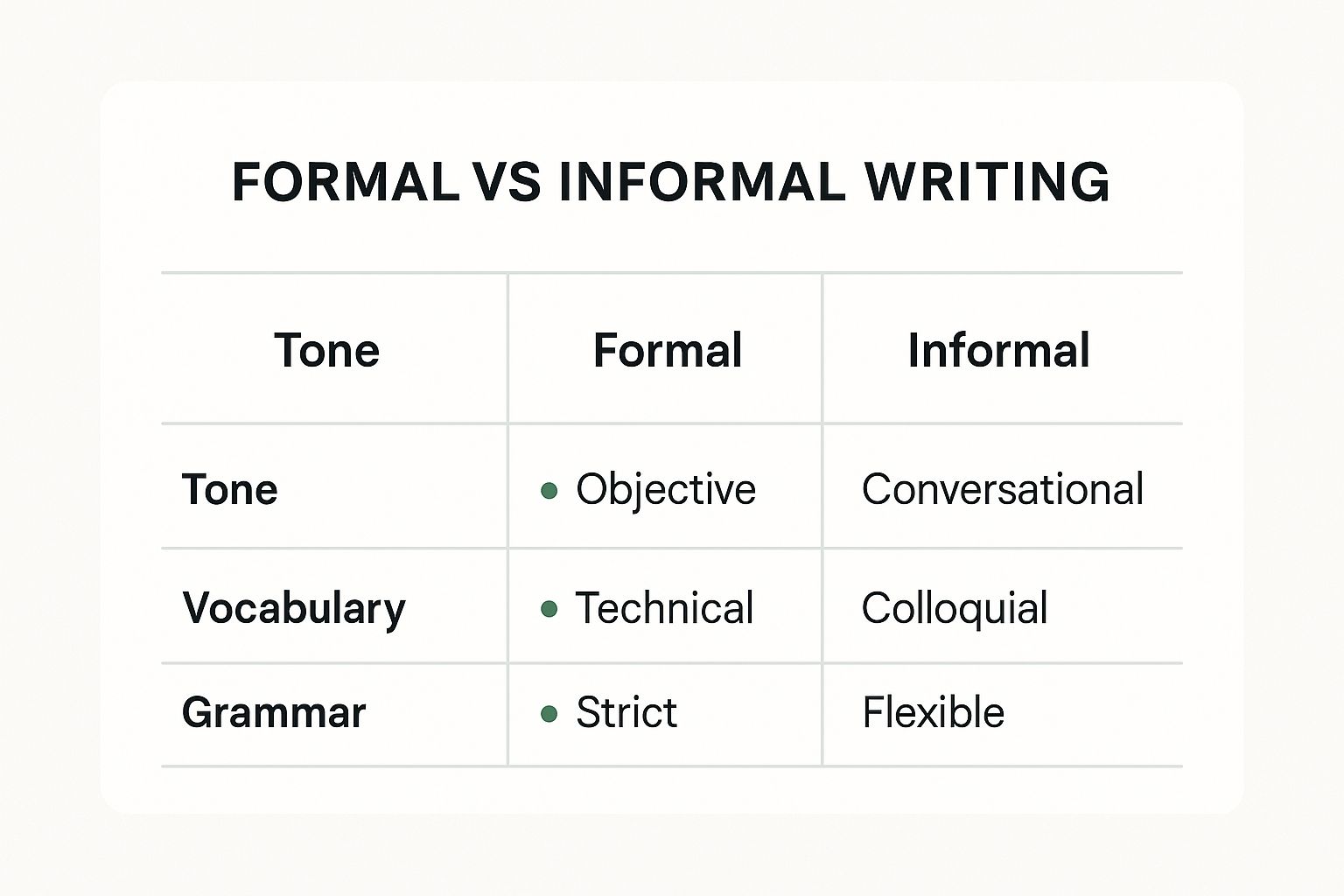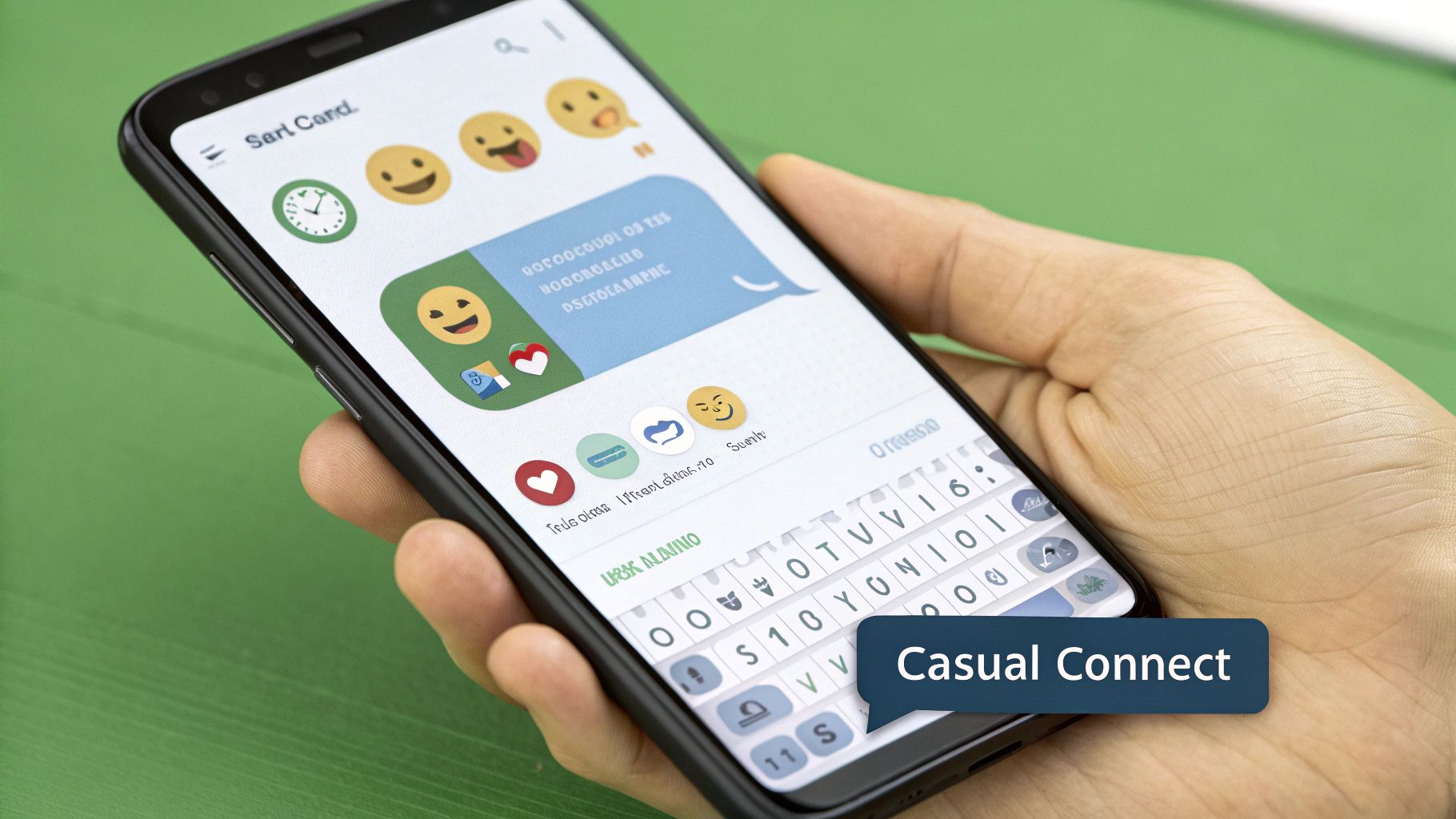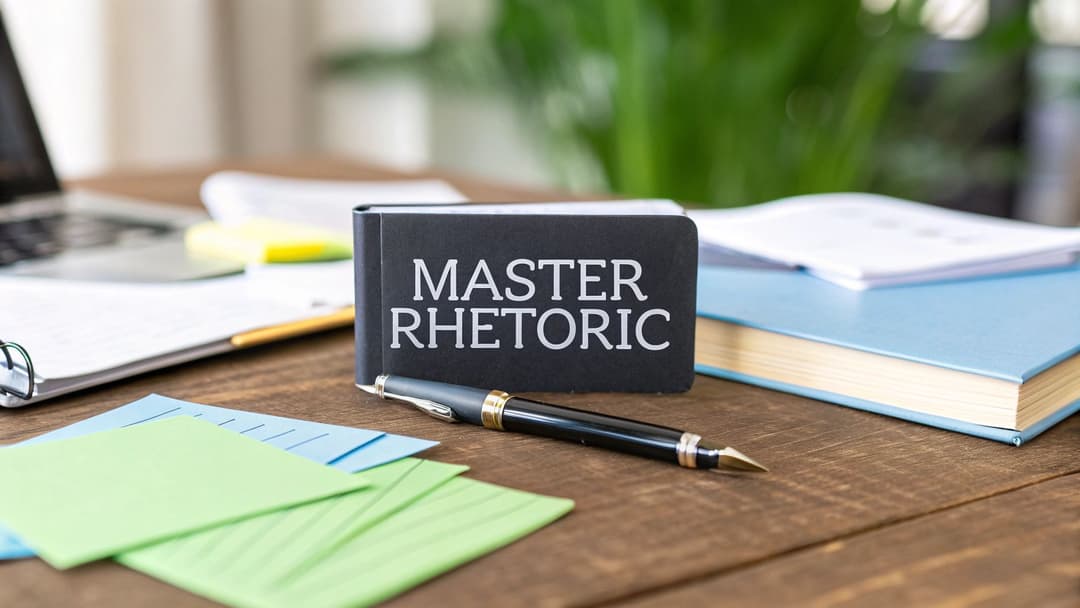
Understanding the Difference Between Formal and Informal Writing
October 19, 2025
The real difference between formal and informal writing boils down to two things: your audience and your purpose. Think of it this way—formal writing is structured, objective, and precise. It's what you'd use for an academic paper, a business proposal, or any official communication.
On the flip side, informal writing is conversational and personal. It’s perfect for blog posts, social media updates, and emails to people you know well.
Key Distinctions at a Glance
Choosing the right style isn't about which one is "better." It's about picking the right tool for the job. Formal writing builds credibility and shows you're serious, while informal writing creates connection and makes you relatable.
Getting a handle on the basic differences in tone, vocabulary, and grammar is the first step to becoming a more flexible and effective writer. If you want to dive deeper, you can explore the best letter writing etiquette, including dos and don'ts for formal vs. informal letters.
This infographic gives you a quick visual breakdown of the core distinctions.

As you can see, every choice you make—from using objective language to sticking with strict grammar rules—sends a clear signal to your reader about your level of professionalism.
Formal vs. Informal Writing At a Glance
For a quick side-by-side reference, here’s a table that lays out the most important characteristics defining each style. It’s a handy cheat sheet for when you’re on the fence.
| Characteristic | Formal Writing | Informal Writing |
|---|---|---|
| Audience | Professional, academic, or unknown audience | Friends, colleagues, or a general online audience |
| Purpose | To inform, persuade, or document officially | To entertain, engage, or communicate casually |
| Tone | Objective, serious, and authoritative | Subjective, personal, and conversational |
| Vocabulary | Precise, technical, and avoids slang | Colloquial, simple, and uses everyday language |
| Structure | Complex sentences, well-developed paragraphs | Shorter sentences, may use fragments |
| Pronouns | Primarily third-person (he, she, they) | Often uses first-person (I, we) and second-person (you) |
| Contractions | Avoided (e.g., do not, it is) | Commonly used (e.g., don't, it's) |
Ultimately, knowing when to switch between these styles is what separates good writers from great ones. It shows you understand not just what you're writing, but who you're writing for.
How Tone and Word Choice Shape Your Message
The quickest way to spot the difference between formal and informal writing is the feeling you get from the tone and vocabulary. Formal writing has an objective, serious tone meant to build authority and credibility. It’s the equivalent of wearing a suit to a job interview—the language is precise, intentional, and shows you know what you’re talking about.
Informal writing, on the other hand, is all about being friendly and approachable. This style uses everyday language to connect with the reader on a personal level. Think of it like a casual chat with a coworker. It’s relaxed, direct, and prioritizes connection over stuffy rules.
The tone you choose isn't an accident; it's a strategic move that signals your relationship with the audience. If you want to dive deeper into this, our guide on what is tone in writing is a great place to start.
The Impact of Vocabulary
Word choice is where the rubber really meets the road. One style goes for precision, the other for relatability.
- Formal Vocabulary: This means using specific, often technical terms while steering clear of slang or casual phrases. You'll see words like "consequently" instead of "so," or "sufficient" instead of "enough."
- Informal Vocabulary: This style welcomes contractions ("can't," "it's"), slang, and simpler words to create a conversational vibe.
This isn't just a stylistic preference. Formal writing consistently uses longer sentences and more complex vocabulary, while informal writing leans on shorter sentences and common language to get the point across without any friction.
Formal Example: “Following a comprehensive analysis of the quarterly financial data, the committee must ascertain the most viable strategy for market expansion.”
Informal Example: “After looking at the numbers from the last three months, we need to figure out the best way to grow.”
See? The core message is exactly the same, but the delivery completely changes how it lands. Mastering this is key, and understanding the principles of effective copywriting for education can really help, since it's all about how your audience receives your message.
Comparing Sentence Structure and Grammar Rules
It’s not just about the words you choose. The very architecture of your sentences—their length, complexity, and flow—signals the difference between formal and informal writing.
Formal writing is built on precision. It often uses longer, more complex sentences to meticulously connect related ideas. Think of clauses linked by transitional phrases like "furthermore" or "consequently." This style also demands a strict adherence to traditional grammar. Paragraphs are carefully structured with clear topic sentences, and the writer keeps a professional distance.

Informal writing, on the other hand, mirrors the natural rhythm of a conversation. It favors shorter, more direct sentences that are easy to digest. This approach makes the content feel more like a one-on-one chat than a lecture.
Flexibility in Informal Grammar
The rules get a lot more relaxed with informal writing. While the goal is still clarity, this style welcomes elements that would feel completely out of place in a formal document.
- Sentence Fragments: Used for emphasis. Like this.
- Direct Address: Speaking directly to "you" is common and helps build a connection.
- Active Voice: Sentences are almost always in the active voice ("We finished the project") instead of the passive ("The project was finished").
- Exclamation Points: These are sprinkled in to show a little enthusiasm and personality.
This flexibility is what makes informal writing so expressive and personal. If you're looking to get better at this, learning how to vary sentence structure is a huge help for both styles. It’s what keeps readers engaged, whether you're writing a dense report or just a quick, friendly email.
A key structural difference is the use of personal pronouns. Formal writing almost exclusively uses the third person (he, she, they) to maintain objectivity. Informal writing warmly welcomes first-person ("I think...") and second-person ("You will see...") perspectives to create a direct connection with the reader.
Ultimately, the structure you pick should serve your purpose. Formal structure builds authority and precision. Informal structure builds connection and relatability.
When to Use Formal Writing for Maximum Impact
Choosing between formal and informal writing isn't just about grammar—it's a strategic decision. Some situations simply demand the precision and authority that only formal writing can deliver. Getting it right shows respect for your audience and the topic, making sure your message lands with the intended weight.
In high-stakes communication, formality is your best friend. It establishes a baseline of professionalism that builds instant credibility. Think of it as the universal language for serious business, where getting the details right is everything.
Academic and Professional Scenarios
Formal writing is the bedrock of academia and most professional fields. Its structured, objective nature is perfect for presenting information clearly and without bias. Without it, complex ideas get muddled, and credibility can take a serious hit.
You'll definitely want to stick to a formal approach in these cases:
- Academic Essays and Research Papers: The whole point here is to build a logical argument backed by solid evidence. An objective, third-person perspective is non-negotiable for maintaining scholarly integrity.
- Official Business Proposals and Reports: When you're talking to clients, stakeholders, or the C-suite, formal language signals that you're serious and ensures every detail is crystal clear.
- Job Applications and Cover Letters: This is your first impression. Formal writing tells a potential employer you're a serious candidate who understands professional norms.
- Legal and Official Correspondence: In contracts, legal notices, or government communication, every single word counts. Formal language is designed to strip away ambiguity and ensure legal precision.
Formal writing is fundamentally about removing ambiguity. Its purpose is to present information in a way that is clear, precise, and universally understood, leaving no room for personal interpretation or emotional bias.
Real-World Formal Writing Examples
To see how this works in practice, look at a classic line from a scientific abstract: "The study's findings indicate a statistically significant correlation between cellular degradation and prolonged exposure to specific environmental toxins." The language is objective, precise, and uses the exact vocabulary of the field.
Or, consider a line from a business contract: "This agreement shall commence upon the date of execution and will remain in effect for a period of twelve (12) months." It’s direct, unambiguous, and legally sound. These examples show why the difference between formal and informal writing is so critical when your credibility and clarity are on the line.
When to Choose Informal Writing to Build Connection
While formal writing builds authority, informal writing builds bridges. It’s the key to making your message feel genuine and relatable, breaking down the barriers that overly stiff language can create.
In a lot of modern communication, a casual tone isn't just acceptable—it’s way more effective.
Think about your daily interactions. Internal team chats on platforms like Slack or Microsoft Teams run on informality. Quick questions, emojis, and a conversational flow build a stronger, more collaborative team than a series of rigid memos ever could. It just makes communication faster and more human.

This principle goes far beyond internal messages. It directly shapes how customers and the public see a brand or an individual.
Where a Casual Tone Wins
Informal writing really shines in situations where connection is the main goal. Its friendly nature makes content more memorable and shareable, which is exactly what you need to grow an audience.
A few common scenarios come to mind:
- Engaging Blog Posts: Most blogs want to inform and connect with readers. An informal, conversational style makes complex topics easier to digest and gets people talking in the comments.
- Social Media Updates: Platforms like Twitter, Instagram, and LinkedIn are built for direct, personal interaction. A casual tone helps your posts sound like they're coming from a real person, not a faceless corporation.
- Friendly Client Emails: For routine updates or check-ins with clients you already know, a slightly informal tone can strengthen the relationship and build trust way better than a cold, formal message.
The strategic use of informal writing comes down to a simple truth of modern communication: people connect with people. A relaxed, conversational style strips away the corporate jargon and lets your authentic voice come through, making your message land with more impact.
Choosing the Right Style for the Situation
Deciding between formal and informal isn't always cut and dried. It depends entirely on your audience, your goal, and the platform you're using. This table breaks down a few common scenarios to help guide your choice.
| Communication Scenario | Recommended Style | Reasoning |
|---|---|---|
| Submitting a job application | Formal | Professionalism and respect are key. You're making a first impression on a potential employer. |
| Writing a company blog post | Informal | The goal is to connect, educate, and engage. A conversational tone feels more approachable. |
| Replying to a customer complaint | Formal (with empathy) | A formal tone shows you're taking the issue seriously, but it should still be human and empathetic. |
| Sending a team-wide project update | Informal | This is internal communication. A casual, direct style is efficient and fosters a collaborative vibe. |
| Publishing an academic paper | Formal | Objectivity, precision, and adherence to established academic standards are non-negotiable. |
| Posting on your brand's social media | Informal | Social media is about building community. A friendly, authentic voice resonates best with followers. |
Ultimately, the choice comes down to the core difference between formal and informal writing—one projects authority, while the other fosters community. Getting this balance right is a game-changer. If you want to nail the casual approach, you can learn more about how to write conversationally to perfect your style.
Choosing informality isn't lazy; it's a smart, strategic move when your goal is to build a real connection.
Adapting Your Writing Style for Any Audience
Knowing the difference between formal and informal writing isn't just about following grammar rules—it's about situational awareness. The real skill is knowing when and how to shift your tone for the biggest impact.
This kind of flexibility is what turns a good writer into a great communicator, someone who can move between different styles without sounding robotic or out of place.
Before you even start typing, get in the habit of asking yourself two quick questions. Answering them honestly is the fastest way to figure out which style will work best.
- Who am I writing for? Think about your relationship with the reader. Is it a potential employer, a trusted colleague, a new client, or just a bunch of people online?
- What do I want to achieve? Pinpoint your goal. Are you trying to establish authority, build a personal connection, give clear instructions, or just be entertaining?
Finding the Middle Ground with Semi-Formal Writing
Most of the time, the right answer isn't strictly formal or totally informal. It's somewhere in between. This "semi-formal" tone is probably the one you use most often without even thinking about it.
It’s perfect for day-to-day communication, like emails to your manager, updates for clients, or announcements to your team.
This balanced approach takes the clarity of formal writing and mixes it with the warmth of an informal tone. You're not using stiff vocabulary or overly complex sentences, but you're also staying away from slang, emojis, or too many contractions.
The ability to consciously choose and adapt your writing style is a powerful tool. It allows you to control how your message is perceived, ensuring it resonates with your intended audience and achieves your communication goals effectively.
Building this awareness is key. One study found that students who participated in activities focused on language standards showed 20-30% higher accuracy when telling formal and informal language apart. It just goes to show that deliberate practice really does sharpen your communication instincts. You can learn more about how language awareness is measured in academic studies.
Writing Styles: Your Questions Answered
When you're trying to figure out the line between formal and informal writing, a few questions pop up all the time. Here are some quick answers to the most common ones.
Can a Blog Post Be Formal?
It can, but it’s pretty rare. Most blogs are built on a friendly, conversational tone because it’s the best way to connect with readers.
That said, you'll definitely see formal writing on blogs from places like scientific journals, law firms, or high-tech companies. They use a formal style to uphold their professional authority and deliver complex information with total precision. It all comes down to who you're talking to and the voice of the brand.
Is It Okay to Mix Formal and Informal Writing?
Generally, no. You should try to avoid mixing styles in the same piece of writing because it can throw the reader off and muddle your message. Consistency is your friend here.
The one exception might be something like a customer service email. You might start off formally to show respect, then shift to a slightly more casual tone once you’ve built a friendly rapport.
The best advice is to pick a style that fits your goal and your audience, then stick with it. An inconsistent tone almost always feels unprofessional, whether you’re writing a formal report or a casual blog post.
This approach sets a clear expectation for the reader from the first sentence to the last.


